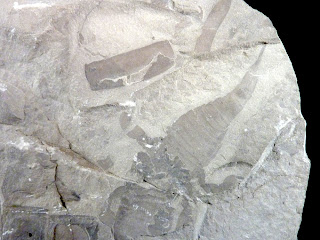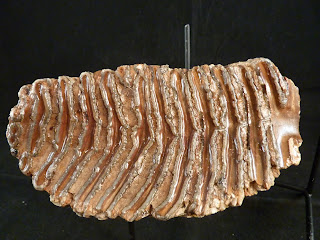The Fossils of complete brittle stars (more commonly called starfish) are rarely found. Brittle stars are marine invertebrates that dwell in all the oceans around the world. Because they have thin exoskeletons they are less likely to fossilize that other
This Moroccan brittle star fossil dates back to the Ordovician Period, over 450 million years ago, and clearly shows the brittle star's five "arms."
These brittle stars are some of the most beautiful and artistic of the fossils waiting to be discovered. Their form, coupled with their incredible shapes make them a true piece of natural art.
For more great Brittle Star Fossils check out
http://www.fossilshack.com/starfish.html
or visit Fossil Shack at
www.fossilshack.com
Fossils
of complete brittle stars (more commonly called starfish) are rarely
found. Brittle stars are marine invertebrates that dwell in all the
oceans around the world. This Moroccan brittle star fossil dates back
to the Ordovician Period, over 450 million years ago, and clearly shows
the brittle star's five "arms." - See more at:
http://www.fireandice.com/ordovician-brittle-star-fossil-from-morocco.html#sthash.s6k0YypQ.dpuf
Fossils
of complete brittle stars (more commonly called starfish) are rarely
found. Brittle stars are marine invertebrates that dwell in all the
oceans around the world. This Moroccan brittle star fossil dates back
to the Ordovician Period, over 450 million years ago, and clearly shows
the brittle star's five "arms." - See more at:
http://www.fireandice.com/ordovician-brittle-star-fossil-from-morocco.html#sthash.s6k0YypQ.dpuf
Fossils
of complete brittle stars (more commonly called starfish) are rarely
found. Brittle stars are marine invertebrates that dwell in all the
oceans around the world. This Moroccan brittle star fossil dates back
to the Ordovician Period, over 450 million years ago, and clearly shows
the brittle star's five "arms." - See more at:
http://www.fireandice.com/ordovician-brittle-star-fossil-from-morocco.html#sthash.s6k0YypQ.dpuf
Fossils
of complete brittle stars (more commonly called starfish) are rarely
found. Brittle stars are marine invertebrates that dwell in all the
oceans around the world. This Moroccan brittle star fossil dates back
to the Ordovician Period, over 450 million years ago, and clearly shows
the brittle star's five "arms." - See more at:
http://www.fireandice.com/ordovician-brittle-star-fossil-from-morocco.html#sthash.s6k0YypQ.dpuf
Fossils
of complete brittle stars (more commonly called starfish) are rarely
found. Brittle stars are marine invertebrates that dwell in all the
oceans around the world. This Moroccan brittle star fossil dates back
to the Ordovician Period, over 450 million years ago, and clearly shows
the brittle star's five "arms." - See more at:
http://www.fireandice.com/ordovician-brittle-star-fossil-from-morocco.html#sthash.s6k0YypQ.dpuf


















































